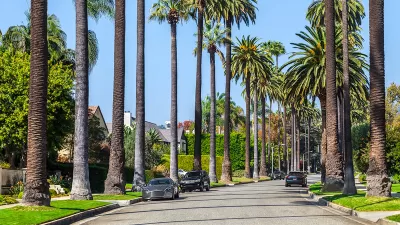Los Angeles has approved new rules aimed at increasing accountability in the planning process—and at preempting a more severe approach promised by an upcoming ballot measure.

The centerpiece of the new rules approved by the Los Angeles City Council is a requirement that the city's 35 community plans be updated on a six-year cycle.
"The plans are so outdated that developers frequently seek permission to skirt the rules, allowing them to build bigger and taller than what the plans allow," explains Curbed LA. Since 2000, 90 percent of these exemptions have been granted, the Los Angeles Times recently found.
The new legislation restructures the review process for these exemptions—which can include height allowances, zoning changes, or General Plan Amendments—to help planning commissioners get a more holistic picture of their impact on the city.
The City Council also approved a plan to create a list of approved consultants from which developers can choose to prepare environmental impact reports.
Fast-tracking General and Community Plan updates was one demand presented to the mayor by backers of the Neighborhood Integrity Initiative, now called Measure S, which will appear before voters on the March 7 ballot. Measure S calls for a two-year moratorium on any such exemptions, during which the city would have to update its General and Community Plans. And it would ban developers from choosing their environmental consultants at all, potentially requiring the city to retain them directly.
City officials including Mayor Eric Garcetti have opposed the measure. PLUM Committee Chair José Huziar, whose district includes Downtown Los Angeles—an area in the midst of a development boom as well as a community plan update—told KPCC that, all in all, the city’s new rules would "make Measure S unnecessary."
FULL STORY: LA council approves rules for more frequent community plan updates

Study: Maui’s Plan to Convert Vacation Rentals to Long-Term Housing Could Cause Nearly $1 Billion Economic Loss
The plan would reduce visitor accommodation by 25,% resulting in 1,900 jobs lost.

North Texas Transit Leaders Tout Benefits of TOD for Growing Region
At a summit focused on transit-oriented development, policymakers discussed how North Texas’ expanded light rail system can serve as a tool for economic growth.

Using Old Oil and Gas Wells for Green Energy Storage
Penn State researchers have found that repurposing abandoned oil and gas wells for geothermal-assisted compressed-air energy storage can boost efficiency, reduce environmental risks, and support clean energy and job transitions.

From Blight to Benefit: Early Results From California’s Equitable Cleanup Program
The Equitable Community Revitalization Grant (ECRG) program is reshaping brownfield redevelopment by prioritizing projects in low-income and environmental justice communities, emphasizing equity, transparency, and community benefits.

Planting Relief: Tackling Las Vegas Heat One Tree at a Time
Nevada Plants, a Las Vegas-based nonprofit, is combating the city’s extreme urban heat by giving away trees to residents in underserved neighborhoods, promoting shade, sustainability, and community health.

How Madison’s Tree Planting Efforts Are Growing a Healthier Community
Madison’s annual tree planting initiative is enhancing environmental resilience, public health, and community livability by adding 1,400 carefully selected trees citywide, with strong community and institutional support for urban forestry.
Urban Design for Planners 1: Software Tools
This six-course series explores essential urban design concepts using open source software and equips planners with the tools they need to participate fully in the urban design process.
Planning for Universal Design
Learn the tools for implementing Universal Design in planning regulations.
Ascent Environmental
Borough of Carlisle
Institute for Housing and Urban Development Studies (IHS)
City of Grandview
Harvard GSD Executive Education
Toledo-Lucas County Plan Commissions
Salt Lake City
NYU Wagner Graduate School of Public Service





























